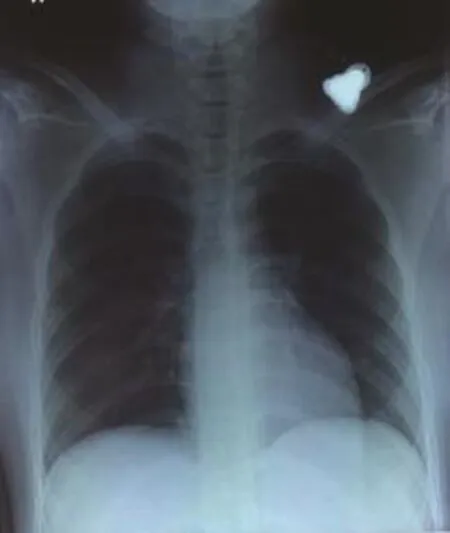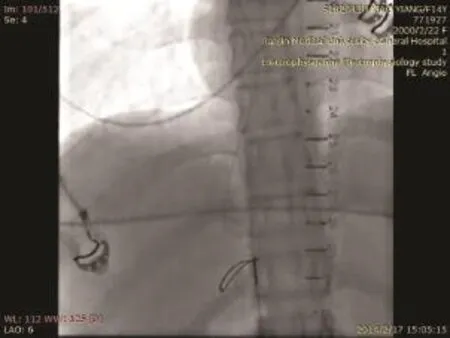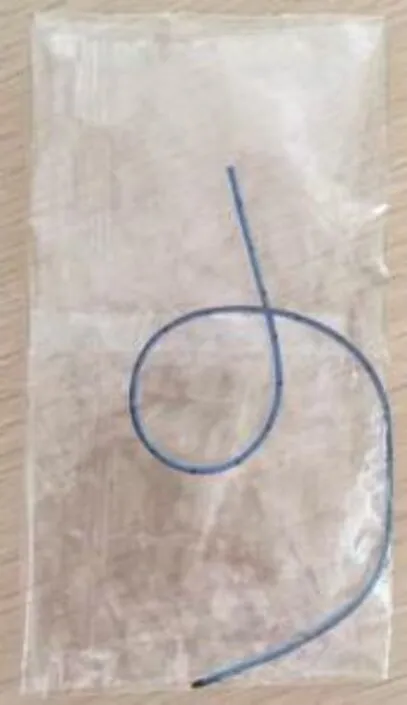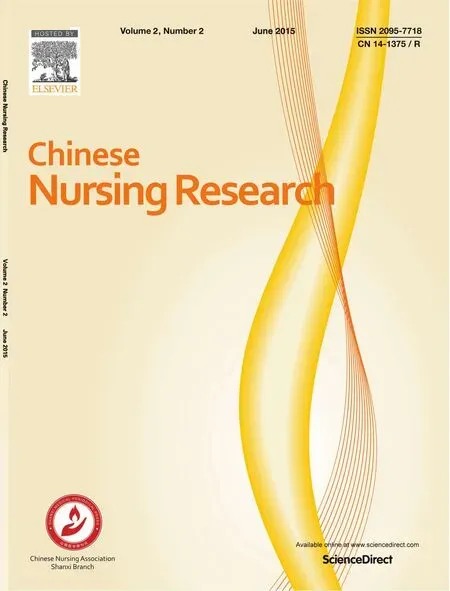A Peripherally Inserted Central Vein Catheter Fractured and Slid into the Right Pulmonary Artery:A Case Report
2015-11-25MengHuZhiChengJieZhngFngHuXioYuLingXingChenDiHiLunFnJieChngZhu
Meng Hu,Zhi-Cheng M,Jie Zhng*,Fng Hu,Xio-Yu Ling,Xing-Chen Di,Hi-Lun Fn,Jie-Chng Zhu*
aDepartment of General Surgery,General Hospital of Tianjin Medical University,Tianjin 300052,China
bDepartment of General Surgery,Tianjin First Central Hospital,Tianjin 300192,China
Original article
A Peripherally Inserted Central Vein Catheter Fractured and Slid into the Right Pulmonary Artery:A Case Report
Meng Hua,Zhi-Cheng Mab,Jie Zhanga*,Fang Hua,Xiao-Yu Lianga,Xiang-Chen Daia,Hai-Lun Fana,Jie-Chang Zhua*
aDepartment of General Surgery,General Hospital of Tianjin Medical University,Tianjin 300052,China
bDepartment of General Surgery,Tianjin First Central Hospital,Tianjin 300192,China
A R T I C L E I N F O
Article history:
4 March 2015
Accepted 22 April 2015
Published 20 June 2015
Peripherally inserted central catheter
Catheter fracture
Interventional operation
Catheter fracture is a rare but serious complication of a peripherally inserted central catheter(PICC).An adolescent patient was sent to Tianjin Medical University General Hospital(Tianjin,China)because the PICC was fractured when removed by a nurse.Chest X-ray showed that the PICC fragment slid into the right pulmonary artery.Through emergency surgery,the remainder of the PICC was successfully retrieved by an interventional operation percutaneously via the right femoral vein.PICC fracture is less common and always without significant discomfort if not found timely,and it may lead to serious complications,such as pulmonary embolism,and even death. Thus,nurses,patients and their family members should pay enough attention to the daily maintenance of PICC and have a deep understanding of the reasons associated with PICC fracture as well as how to prevent it.Interventional operation is minimally invasive,which is a good choice for the removal of intravascular foreign bodies,leading to fewer complications and a good prognosis.
ⓒ2015 Shanxi Medical Periodical Press.Production and hosting by Elsevier B.V.This is an open access article under the CC BY-NC-ND license(http://creativecommons.org/licenses/by-nc-nd/4.0/).
1.Introduction
A peripherally inserted central catheter(PICC)is a catheter that is placed in a peripheral vein(usually basilic vein,cephalic vein,or median cubital vein)and travels along the brachial vein,axillary vein,and subclavian vein until it reaches the superior vena cava.1PICC is a good choice for prolonged venous access.Patients may go back home with the catheter retained in place and use it for up to one year.It is free of the pain and stress associated withfrequentvenepuncture.2Nevertheless,PICC is a foreign body in vessels and can result in some complications,such as thrombosis,infection,phlebitis,and so on.3,4Catheter fracture is a rare complication. The first report describing the embolization by a fractured PICC line to the pulmonary artery was published in 1995 in Japan by Linz DN.5The accurate incidence rate of PICC fracture is unknown due to a lack of long-term,large-scale,and prospective studies.6However,PICC fracture is potentially life-threatening and may result in serious outcomes.Early detection may help to prevent significant mortality.Retrieval of the fractured PICC fragment can now be accomplished with radio graphical assistance using percutaneous techniques,which have a high success rate of more than 90%,with few complications.5,7
2.Case presentation
A 14-year-old girl suffering from acute lymphoid leukaemia required a standard 4-Fr peripherally inserted central venous catheter(PICC)produced by Bard 10 months after chemotherapy.After long-term treatment,the girl recovered and planned to remove the catheter. When a qualified nurse removed the PICC catheter,she found that the puncture point and surrounding skin was in good condition;however,the catheter was hard to remove and the girl was very quiet and did not feel pain. Thus,the nurse vigorously pulled to remove it,and the catheter subsequently cracked,leaving approximately 26 cm of the catheter in the body.The girl had no cardiac or pulmonary symptoms.Chest X-ray showed that the PICC slid into the right pulmonary artery 4 cm from the hilus(Fig.1).Next,the girl was sent to Tianjin Medical University General Hospital(Tianjin,China),and an emergency interventional operation was performed on her.The surgeon inserted an 8F arterial sheath via the right femoral vein using Seldinger technology and found that the PICC catheter was located in the right branch of the pulmonary artery.Next,the PICC was wrapped using a‘pig tail pipe'and dragged into the inferior vena cava;the PICC fragment was subsequently pulled out using a snare pull(Fig.2).The introducer sheath(Fig.3)was removed,and local oppression haemostasis was applied for 6 h.

Fig.1.Chest radiograph demonstrating the fractured PICC fragment lodged in the right pulmonary artery.

Fig.2.PICC fragment retrieved from the right pulmonary artery.

Fig.3.Removal of the fractured PICC fragment from the inferior vena cava using a snare pull.
3.Discussion
Catheter fracture is a rare complication of PICC lines and is potentially life threatening.In recent years,PICC demonstrated many benefits compared with tunnelled central venous lines,and it is widely used in the clinic,particularly in patients suffering from cancer and who are critically ill.It is mainly used for prolonged antibiotic therapy,total parental nutrition and chemotherapy.5,7,8Catheter fracture is a less common complication,and it mainly occurs at or near the entrance site when removing the PICC line.3,9Because the PICC is long and soft,once it is broken,it shifts in blood into the right atrium or pulmonary artery and often may not cause significant symptoms.If not found,it may result in serious outcomes,such as pulmonary embolism and even death. Thus,health care providers should be aware of these potential complications and be familiar with the factors that are associated with catheter fracture and understand how to prevent it.5,10
Chow et al.10indicated that catheter fatigue is associated with the breakage of the PICC.They found that the average time of PICC fracture from insertion to discovery was 93 days.In this case,the PICC had been retained for 10 months.Older catheters become fragile and are prone to breakage.Over time,since the PICC is a foreign body in the vessels,it facilitates fibrin binding. However,weekly sterile dressing changes and chemotherapeutic drugs also corrode the catheter,aggravating the fatigue of the PICC.9The PICC should be removed in time if there is no indication for its use or it does not work well.8,9
In addition,complications,such as blockage or leaking at the insertion site,also contribute to catheter fracture.If a nurse flushes the blocked lines with too much manual force or uses small(<10 mL)syringes,breakageofthecatheterwallcanoccurunderhigh pressure.10
This case report tells readers how a PICC broke during its removal and how it subsequently slid into the right pulmonary artery and was finally removed by interventional operation.Compared with traditional surgery,interventional surgery is safer and simpler,with fewer complications.Interventional surgery is the most efficient way to remove the broken catheter that slipped into central vein,heart and pulmonary arteries.5,7
Although the duration is a critical factor for the breakage of the PICC,routine removal or reinsertion is not recommended because it brings risks and costs to patients.9Daily maintenance of the lines is very important.10Insertion and maintenance of the catheter can be accomplished by specially trained nurses using a strict aseptic technique.The catheter should be flushed using a syringe that is larger than 10 mL before and after its use,and it should be flushed routinely every 8 h independent of its use.Patients and their family members should be educated on how to protect the lines,particularly after the patients are discharged.Patients should not use the arm with PICC line to lift heavy objects,play badminton,table tennis or other strenuous exercises.If patients would like to take a bath,then they can use a fresh film to wrap the arm with the PICC line to protect it.In addition,they should know the symptoms and signs of possible PICC breakage and report any problems to the health care providers.9,10
When removing the PICC,nurses should make patients feel relaxed and not nervous.If the catheter is difficult to remove,then multiple hot soaks should be applied on top of the insertion site to make the vessels expand.If the nurses still feel that it is difficult,then they should try removal after 12-24 h.However,forcibly pulling the lines out is strictly prohibited.When the line has been removed,nurses should carefully examine it to see if it is intact.
4.Summary
This report describes a fractured PICC and embolization in the right pulmonary artery of a 14-year-old child. It also discusses the risk factors related to the PICC fracture,and emphasizes the importance of nursing care and education for patients and their family members to decrease the possibility of PICC fracture.
Conflicts of interest
All contributing authors declare no conflicts of interest.
Acknowledgements
The authors would like to thank the patient for providing us with her signed written informed consent for publication of this case study.
References
1.Huhhes ME.PICC-related thrombosis:pathophysiology,incidence,morbidity and the effect of ultrasound-guided placement technique on occurrence in cancer patients.J Assoc Vasc Access.2011;16:8-18.
2.Shen G,Gao Y,Wang Y,Mao B,Wang X.Survey of the long-term use of peripherally inserted central venous catheters in children with cancer experience in a developing country.J Pediatr Hematol Oncol.2009;31:489-492.
3.Kossoff EH,Poirier MP.Peripherally inserted central venous catheter fracture and embolization to the lung.Pediatr Emerg Care.1998;14:403-405.
4.Loughran SC,Borzatta M.Peripherally inserted central catheters:a report of 2506 catheter days.J Parenter Enteral Nutr. 1995;19:133-136.
5.Linz DN,Bisset GS 3rd,Warner BW.Fracture and embolization of a peripherally inserted central venous catheter.J Parenter Enteral Nutr.1994;18:79-80.
6.Thanigaraj S,Panneerselvam A,Yanos J.Retrieval of an IV catheter fragment from the pulmonary artery 11 years after embolization.Chest.2000;117:1209-1211.
7.Motta Leal Filho JM,Carnevale FC,Nasser F,et al.Endovascular techniques and procedures,methods for removal of intravascular foreign bodies.Rev Bras Cir Cardiovasc.2010;25:202-208.
8.Sette P,Dorizzi RM,Azzini AM.Unexpected obstacle in catheter removal could be due to knots spontaneously forming in peripherally inserted central catheters(PICC).J Vasc Access.2011;12:387-388.
9.No authors listed.Breakage of a PICC Line.AORN J.2011;93:369-370.
10.Chow LM,Friedman JN,Macarthur C,et al.Peripherally inserted central catheter(PICC)fracture and embolization in the pediatric population.J Pediatr.2003;142:141-144.
Original article
8 December 2014
in revised form
.
E-mail address:wxq_bf@sina.com(J.Zhang).
Peer review under responsibility of Shanxi Medical Periodical Press.
http://dx.doi.org/10.1016/j.cnre.2015.09.005
2095-7718/ⓒ2015 Shanxi Medical Periodical Press.Production and hosting by Elsevier B.V.This is an open access article under the CC BY-NC-ND license(http://creativecommons.org/licenses/by-nc-nd/4.0/).
杂志排行
Frontiers of Nursing的其它文章
- An Experimental Study on RBC Count and Serum Potassium Concentration Changes During Compression Transfusion of WBC-removal Whole Blood☆
- Logistic Regression Analysis and Nursing Interventions for High-risk Factors for Pressure Sores in Patients in a Surgical Intensive Care Unit
- The Relationship between Social Support and Burnout among ICU Nurses in Shanghai:A Cross-Sectional Study
- Relationship Between Self-efficacy Beliefs and Achievement Motivation in Student Nurses☆
- Factors Influencing Pre-hospital Patient Delay in Patients with Acute Myocardial Infarction
- Caring for and Keeping the Elderly in Their Homes
